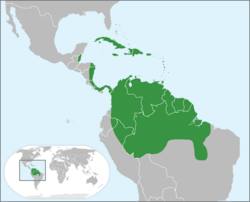Biology:Carapa
| Carapa | |
|---|---|

| |
| Carapa guianensis | |
| Scientific classification Error creating thumbnail: Unable to save thumbnail to destination
| |
| Kingdom: | Plantae |
| Clade: | Tracheophytes |
| Clade: | Angiosperms |
| Clade: | Eudicots |
| Clade: | Rosids |
| Order: | Sapindales |
| Family: | Meliaceae |
| Subfamily: | Cedreloideae |
| Genus: | Carapa Aubl. |
| Species | |
|
See text | |

| |
| Range of Carapa guianensis | |
Carapa is a genus of flowering plants in the mahogany family, Meliaceae. These are trees up to 30 meters tall occurring in tropical South America, Central America,[1] and Africa. Common names include andiroba and crabwood.
Diversity
The list of species within this genus is still under discussion. Generally recognized species are:
- Carapa guianensis (andiroba, crabwood): Amazon Region, Central America, Caribbean
- Carapa megistocarpa (tangare): Ecuador
- Carapa procera (African crabwood, kowi, okoto): West Africa, the Congos
Other proposed species:
Uses
The timber is important, and oil is produced from the seeds. The name andiroba is from Nheengatu nhandi rob, meaning "bitter oil". Carapa guianensis produces oil similar[clarification needed] to neem oil.
The oil contained in the almond andiroba is light yellow and extremely bitter. When subjected to a temperature below 25 °C, it solidifies producing a consistency like that of petroleum jelly. The oil contains olein, palmitine and glycerin.[citation needed]
Andiroba oil is one of the most commonly sold medicinal oils in the Amazon.[citation needed] It is also used to repel mosquitoes by forming an oilseed cake into balls and burned, or mixed with annatto (Bixa orellana) and formed into a paste applied topically to protect the body from mosquito bites.[5]
Andiroba oil is extracted from light brown seeds collected from beaches and rivers, where they float after being shed by the trees or from the forest ground.
References
- ↑ Hogan, C. M. 2008. Isthmian-Atlantic moist forests. Encyclopedia of Earth, World Wildlife Fund, National Council of Science and the Environment.
- ↑ Forget P. M. (2009). "A new species of Carapa (Meliaceae) from Central Guyana". Brittonia 61 (4): 366–74. doi:10.1007/s12228-009-9090-z. http://www.carapa.org/data/File/CARAPA/2009Forgetetal_Brittonia_Carapa_GUY.pdf. Retrieved 2013-07-24.
- ↑ 3.0 3.1 Kenfack D.; Peréz A. J. (2011). "Two new species of Carapa (Meliaceae) from western Ecuador". Systematic Botany 36 (1): 124–28. doi:10.1600/036364411X553207.
- ↑ Kenfack D (2011). "Carapa vasquezii (Meliaceae), a new species from western Amazonia". Brittonia 63 (1): 7–10. doi:10.1007/s12228-010-9163-z. http://cdam.minam.gob.pe:8080/bitstream/123456789/903/1/0000778.pdf.[yes|permanent dead link|dead link}}]
- ↑ "Comparative study of the topical effectiveness of the Andiroba oil (Carapa guianensis) and DEET 50% as repellent for Aedes sp". Rev Inst Med Trop Sao Paulo 46 (5): 253–6. 2004. doi:10.1590/s0036-46652004000500004. PMID 15517027.
External links
Wikidata ☰ Q2937888 entry
 |


